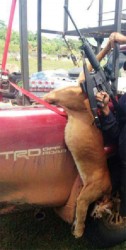Dear Editor,
I am writing to convey my deep concern about the growing trend of recreational hunters, now armed with high-powered rifles, wantonly slaughtering animals for sport in our forest. I was horrified to see gruesome photographs of some of these hunters proudly posing with their trophy wildcats such as a pregnant puma strung up by her tail at the back of a pickup, and dead jaguars and deer in the tray of another. Even if these hunters were unaware that these wildcats are an endangered species and are protected under our Wildlife Regulations, I am at a loss as to their reckless slaughter of animals not intended for consumption.
Our forests are becoming more easily accessible and there is a clear need for some immediate monitoring mechanisms to be in place to curb these practices. For starters I would like to recommend the following interventions:
 The companies who are constructing these roads into our forests should be responsible for placing clearly visible billboards warning of the illegality of killing protected species, and for producing posters for distribution with the same message.
The companies who are constructing these roads into our forests should be responsible for placing clearly visible billboards warning of the illegality of killing protected species, and for producing posters for distribution with the same message.
Knowledgeable members from communities near the entrance and exit of these roads should be trained as rangers by the Wildlife Division of the Environmental Protection Agency and empowered to enforce the regulations against this wanton killing.
A mechanism should be developed between the road developers and the personnel of the field stations of the regulatory agencies which would control access to these wilderness areas and take necessary action against any hunter caught with carcasses of protected species.
Our animals are being harvested for the wildlife trade and for the supply of meat to the mining and forestry camps. This decimation by recreational hunters with high-powered rifles and customized vehicles is also a threat to our fledgling tourism industry as our visitors may soon only be able to see our beautiful wildlife in the Georgetown Zoo.
There is also the potential significant backlash from the very visitors we are straining to attract who would be shocked by this practice and would speak out vehemently against it.
The disturbing photos of these killings were sent to me by a concerned citizen, and I have shared them with our regulatory agencies to whom such photos should also be sent to in future as they have committed to taking necessary action.
I am prepared to play my part in doing whatever is necessary to have this threat managed, and I believe in speaking to hunters directly to enlist their support, but my efforts to do so with the hunter identified in a few of the photos proved futile.
As such I close by sharing the photo of the dead pregnant puma which speaks for itself, and by calling on the general public to come on board to represent these defenceless forest creatures who are voiceless.
Yours faithfully,
Annette Arjoon Martins

